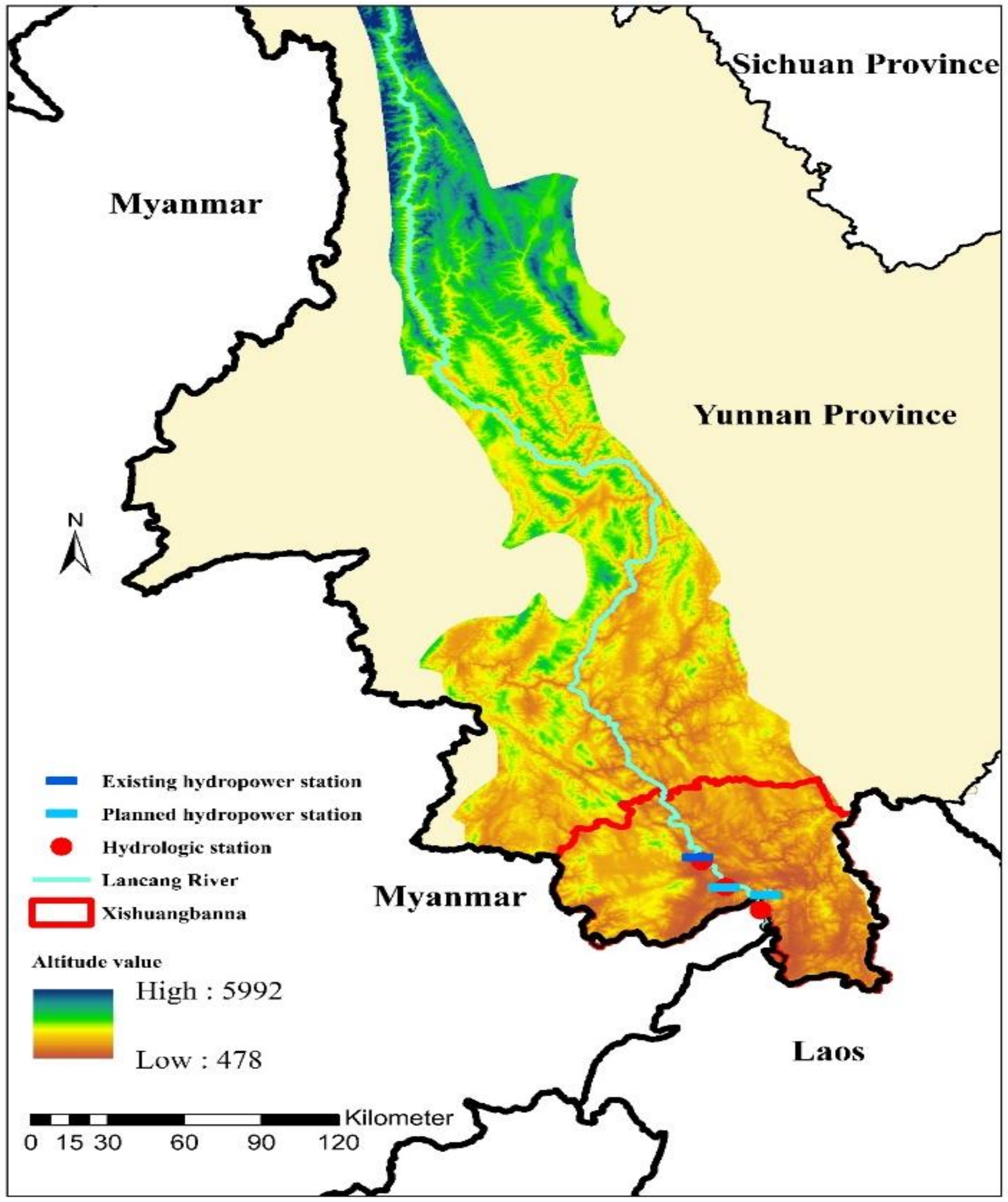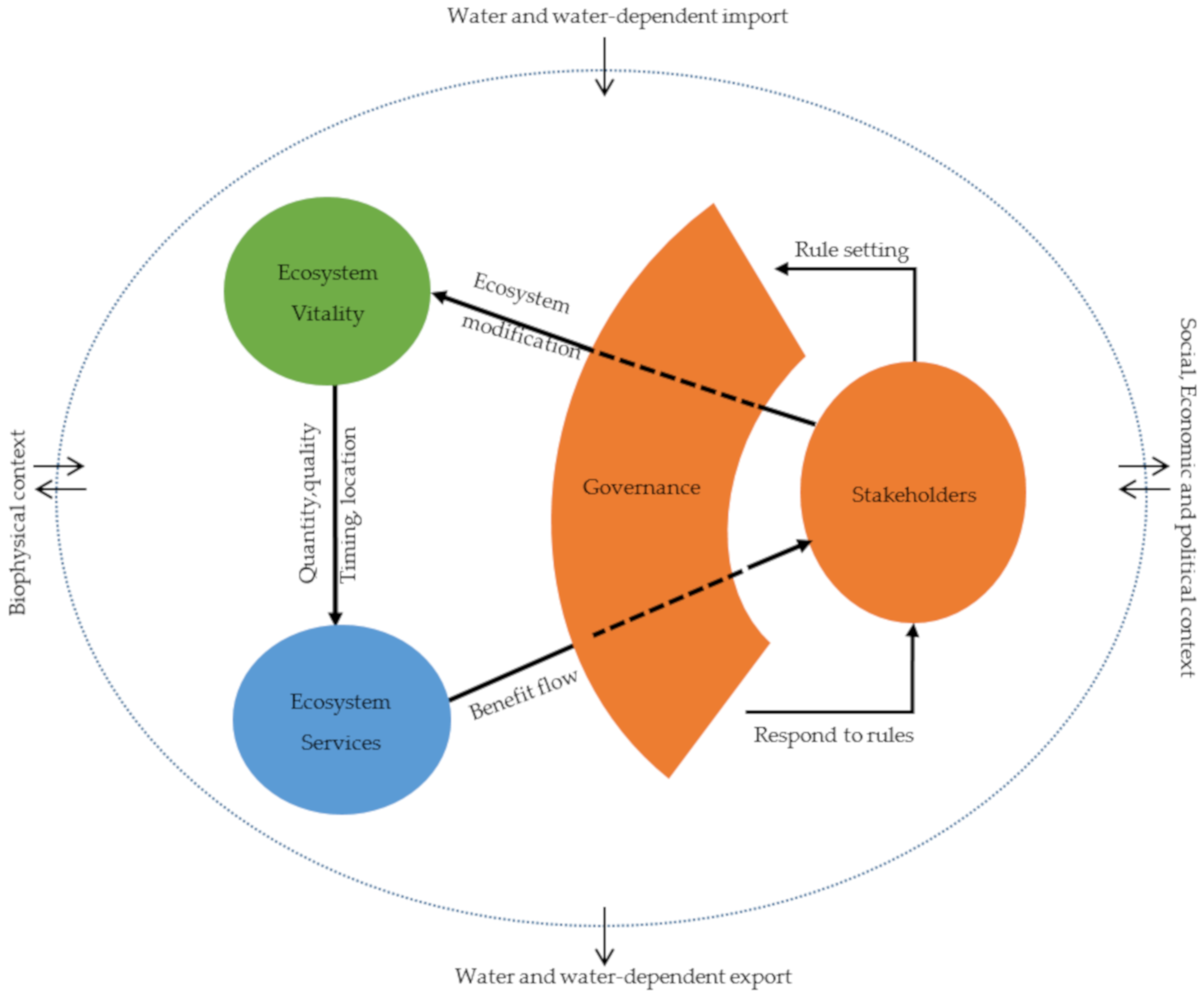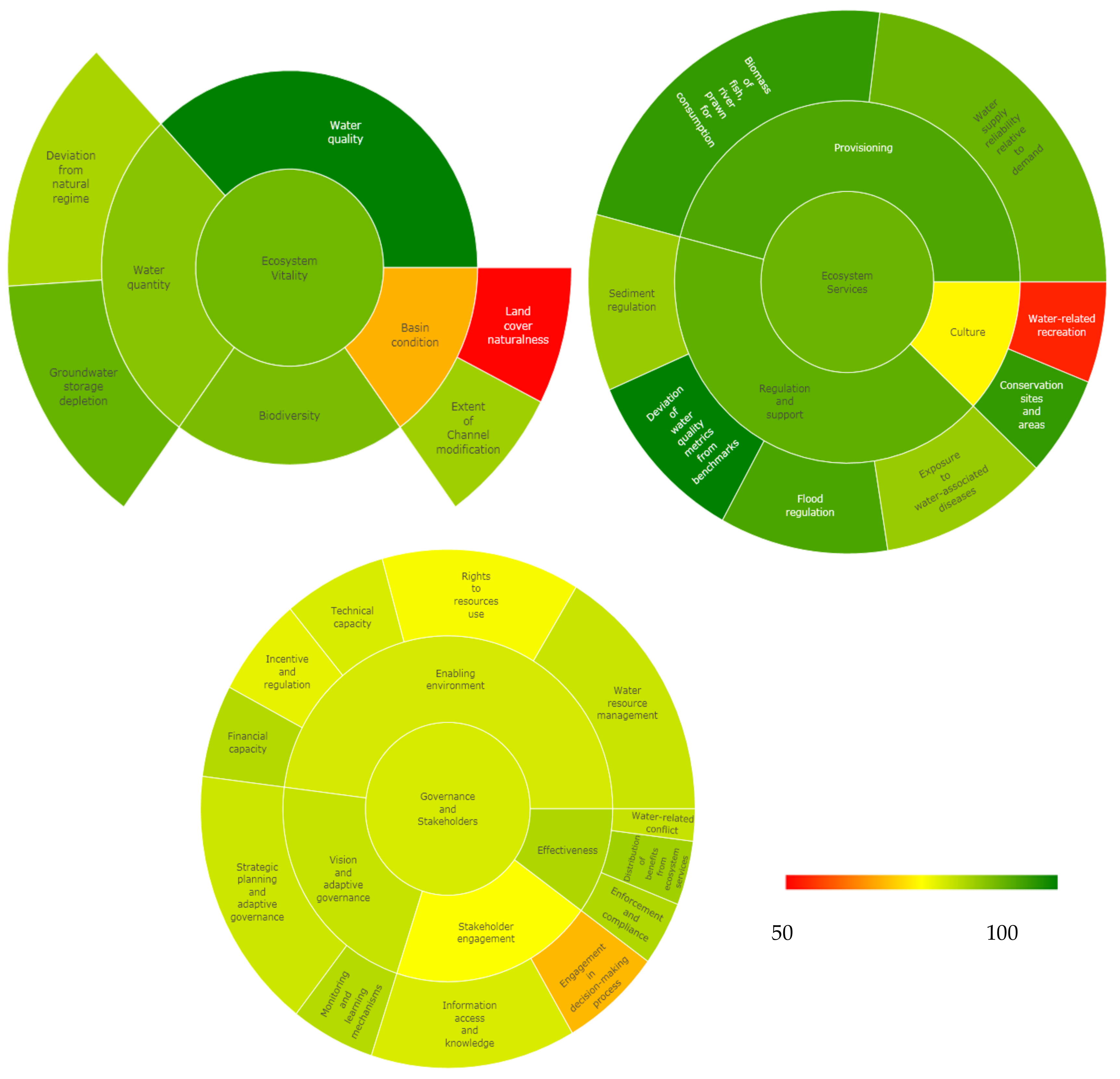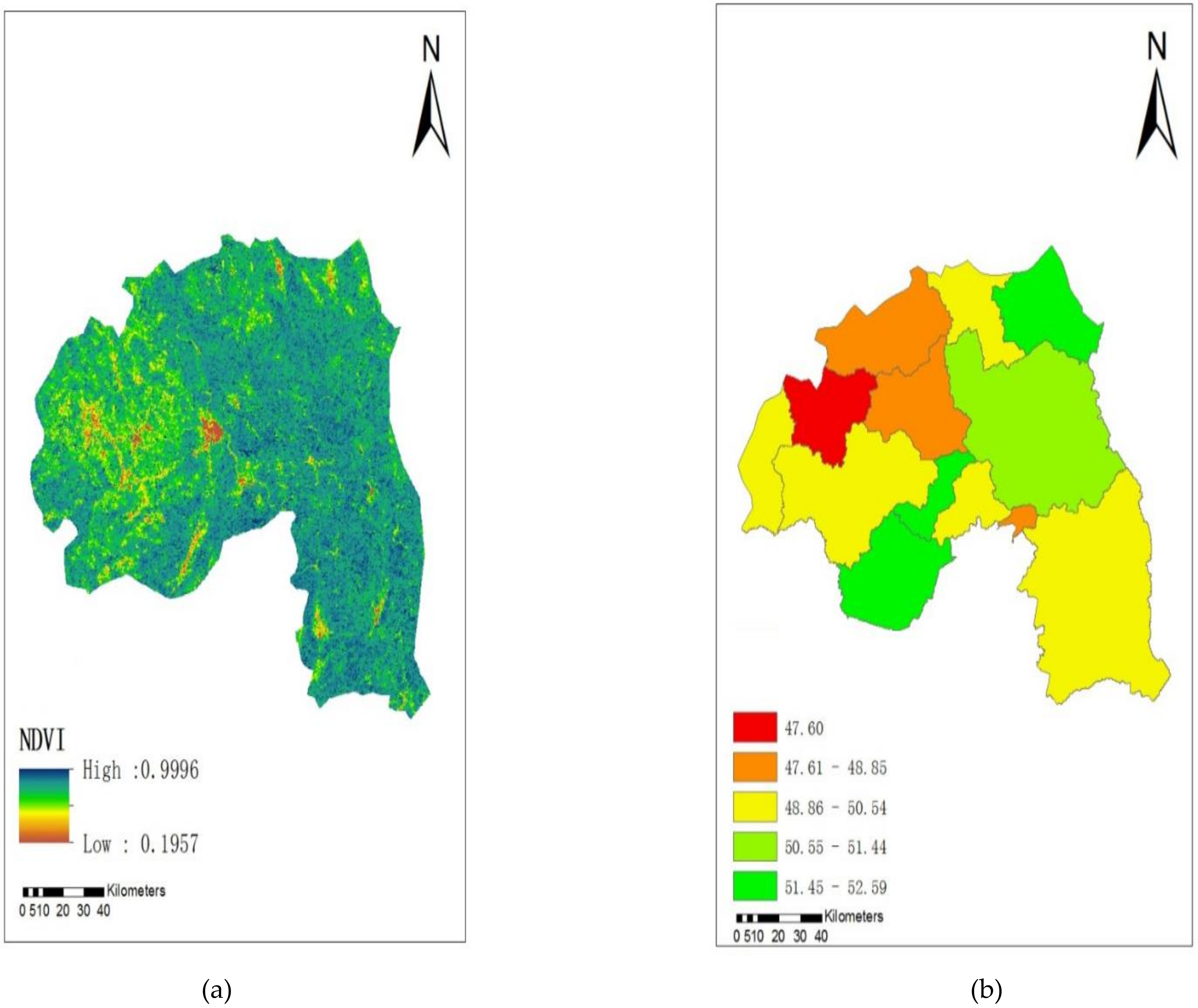Comprehensive Study on Freshwater Ecosystem Health of Lancang River Basin in Xishuangbanna of China
Abstract
1. Introduction
2. Study Framework
2.1. Study Area
2.2. Establishment of the Indices System
2.3. Measurement and Aggregation of the Indicators
2.3.1. Deviation from Natural Regime
2.3.2. Groundwater Depletion
2.3.3. Water Quality
2.3.4. Extent of Channel Modification
2.3.5. Land Cover Naturalness
2.3.6. Biodiversity
2.3.7. Sub-Indicators for Ecosystem Services
2.3.8. Sub-Indicators for Governance and Stakeholders
2.3.9. Aggregation of the Indicators
3. Results
3.1. Weights and Indicator Scores for Lancang River in Xishuangbanna
3.2. Ecosystem Vitality and Ecosystem Services
3.3. Governance and Stakeholders
4. Discussion
Author Contributions
Funding
Acknowledgments
Conflicts of Interest
References
- Baran, E. Mekong fisheries and mainstream dams. In Mekong River Commission Strategic Environmental Assessment of Hydropower on the Mekong Mainstream; International Centre for Environmental Management: Hanoi, Vietnam, 2010. [Google Scholar]
- Xie, K.; Yang, G.; Xiao, G. The geochemical characteristics of chemical element and prospecting potential in Lancang River Southern. J. Yunnan Univ. 2012, 34, 148–156. [Google Scholar]
- Cheng, X.; Shen, L.; Gao, T. Development status of mineral resources in five countries of the Indochina peninsula and investment preferences for China. Resour. Sci. 2011, 33, 1847–1854. [Google Scholar]
- Asian Development Bank. Available online: https://www.adb.org/sites/default/files/project-document/66023/37576-cam-tacr.pdf (accessed on 6 February 2020).
- Ruan, L.; Jiang, Y.; Lv, L.; Lin, H.; Pang, Q. Analysis on rice production and international trade in Vietnam. Hybrid Rice 2011, 26, 75–78. [Google Scholar]
- Asian Development Bank. Available online: https://www.adb.org/sites/default/files/publication/435341/projecting-industrial-pollution-gms.pdf (accessed on 15 February 2020).
- Sun, C.; Xiao, Z.; Sun, J.; Yu, E. Projection of temperature change and extreme temperature events in the Lancang-Mekong River basin. Atmos. Ocean. Sci. Lett. 2020, 13, 16–25. [Google Scholar] [CrossRef]
- Thirumalai, K.; Dinezio, P.N.; Okumura, Y.; Deser, C. Extreme temperatures in southeast Asia caused by El Niño and worsened by global warming. Nat. Commun. 2017, 8, 15531. [Google Scholar] [CrossRef] [PubMed]
- Ding, N.; Yang, W.; Zhou, Y.; Gonzalez-Bergonzoni, I.; Zhang, J.; Chen, K.; Vidal, N.; Jeppesen, E.; Liu, Z.; Wang, B. Different responses of functional traits and diversity of stream macroinvertebrates to environmental and spatial factors in the Xishuangbanna watershed of the upper Mekong River Basin, China. Sci. Total Environ. 2017, 574, 288–299. [Google Scholar] [CrossRef]
- Liu, S.; Dong, Y.; Cheng, F.; Zhang, Y.; Hou, X.; Dong, S.; Coxixo, A. Effects of road network on Asian elephant habitat and connectivity between the nature reserves in Xishuangbanna, Southwest China. J. Nat. Conserv. 2017, 38, 11–20. [Google Scholar] [CrossRef]
- Xu, J.; Grumbine, R.E.; Beckschaefer, P. Landscape transformation through the use of ecological and socioeconomic indicators in Xishuangbanna, Southwest China, Mekong Region. Ecol. Indic. 2014, 36, 749–756. [Google Scholar] [CrossRef]
- Xiao, C.; Li, P.; Feng, Z. Monitoring annual dynamics of mature rubber plantations in Xishuangbanna during 1987–2018 using Landsat time series data: A multiple normalization approach. Int. J. Appl. Earth Obs. Geoinf. 2019, 77, 30–41. [Google Scholar] [CrossRef]
- Liu, S.; Yin, Y.; Li, J.; Cheng, F.; Dong, S.; Zhang, Y. Using cross-scale landscape connectivity indices to identify key habitat resource patches for Asian elephants in Xishuangbanna, China. Landsc. Urban. Plan. 2018, 171, 80–87. [Google Scholar] [CrossRef]
- Shi, M.; Huang, J.; Waibel, H.; Yang, X.; Cadisch, G. Rubber boom, land use change and the implications for carbon balances in Xishuangbanna, Southwest China. Ecol. Econ. 2019, 156, 57–67. [Google Scholar]
- Wang, S.; Wang, H.; Li, J.; Zhang, Z. Ants can exert a diverse effect on soil carbon and nitrogen pools in a Xishuangbanna tropical forest. Soil Biol. Biochem. 2017, 113, 45–52. [Google Scholar] [CrossRef]
- Sun, Y.; Ma, Y.; Cao, K.; Li, H.; Shen, J.; Liu, W.; Di, L.; Mei, C. Temporal changes of ecosystem carbon stocks in rubber plantations in Xishuangbanna, southwest China. Pedosphere 2017, 27, 737–746. [Google Scholar] [CrossRef]
- Fan, H.; He, D.; Wang, H. Environmental consequences of damming the mainstream Lancang-Mekong River: A review. Earth Sci. Rev. 2015, 146, 77–91. [Google Scholar] [CrossRef]
- Tan, J.; Li, A.; Lei, G.; Bian, J.; Zhang, Z. A novel and direct ecological risk assessment index for environmental degradation based on response curve approach and remotely sensed data. Ecol. Indic. 2019, 98, 783–793. [Google Scholar] [CrossRef]
- Boulton, A.J. An overview of river health assessment: Philosophies, practice, problems and prognosis. Freshw. Biol. 1999, 41, 469–479. [Google Scholar] [CrossRef]
- Karr, J.R. Defifining and measuring river health. Freshw. Biol. 1999, 41, 221–234. [Google Scholar] [CrossRef]
- Dos Santos, D.A.; Molineri, C.; Reynaga, M.C.; Basualdo, C. Which index is the best to assess stream health? Ecol. Indic. 2011, 11, 582–589. [Google Scholar] [CrossRef]
- Meyer, J.L. Stream health: Incorporating the human dimension to advance stream ecology. J. N. Am. Benthol. Soc. 1997, 16, 439–447. [Google Scholar] [CrossRef]
- Vugteveen, P.; Leuven, R.S.E.W.; Huijbregts, M.A.J.; Lenders, H.J.R. Redefifinition and elaboration of river ecosystem health: Perspective for river management. Hydrobiologia 2006, 565, 289–308. [Google Scholar] [CrossRef]
- Malaj, E.; von der Ohe, P.C.; Grote, M.; Kuhne, R.; Mondy, C.; Usseglio-Polatera, P.; Brack, W.; Schafer, R. Organic chemicals jeopardize the health of freshwater ecosystems on the continental scale. Proc. Natl. Acad. Sci. USA 2014, 111, 9549–9554. [Google Scholar] [CrossRef] [PubMed]
- Famiglietti, J.S. The global groundwater crisis. Nat. Clim. Chang. 2014, 4, 945–948. [Google Scholar] [CrossRef]
- Dai, A. Increasing drought under global warming in observations and models. Nat. Clim. Chang. 2013, 3, 52–58. [Google Scholar] [CrossRef]
- Hirabayashi, Y.; Mahendran, R.; Koirala, S.; Konoshima, L.; Yamazaki, D.; Watanabe, S.; Kim, H.; Kanae, S. Global flood risk under climate change. Nat. Clim. Chang. 2013, 3, 816–821. [Google Scholar] [CrossRef]
- Pires, A.; Morato, J.; Peixoto, H.; Botero, V.; Zuluaga, L.; Figueroa, A. Sustainability assessment of indicators for integrated water resources management. Sci. Total Environ. 2017, 578, 139–147. [Google Scholar] [CrossRef]
- Vollmer, D.; Regan, H.M.; Andelman, S.J. Assessing the sustainability of freshwater systems: A critical review of composite indicators. Ambio 2016, 45, 765–780. [Google Scholar] [CrossRef]
- Vollmer, D.; Shaad, K.; Souter, N.J.; Farrell, T.; Dudgeon, D.; Sullivan, C.A.; Fauconnier, I.; MacDonald, G.M.; McCartney, M.P.; Power, A.G.; et al. Integrating the social, hydrological and ecological dimensions of freshwater health: The Freshwater Health Index. Sci. Total Environ. 2018, 627, 304–313. [Google Scholar] [CrossRef]
- Zhu, H.; Cao, M.; Hu, H. Geological history, flflora, and vegetation of Xishuangbanna, Southern Yunnan, China. Biotropica 2006, 38, 310–317. [Google Scholar] [CrossRef]
- Zomer, R.J.; Trabucco, A.; Wang, M.; Lang, R.; Chen, H.; Metzger, M.J.; Smajgl, A.; Beckschäfer, P.; Xu, J. Environmental stratification to model climate change impacts on biodiversity and rubber production in Xishuangbanna, Yunnan, China. Biol. Conserv. 2014, 170, 264–273. [Google Scholar] [CrossRef]
- Zhu, H.; Wang, H.; Li, B.; Zhou, S.; Zhang, J. Studies on the forest vegetation of Xishuangbanna. Plant. Sci. J. 2015, 33, 641–726. [Google Scholar]
- Statistics Bureau of Xishuangbanna Dai Autonomous Prefecture. Available online: https://tjj.xsbn.gov.cn/312.news.list.dhtml (accessed on 26 March 2020).
- China Natural Resoures Series Compilation Committee. China Natural Resources Series: Yunnan Volume; 1st ed.China Environmental Press: Beijing, China, 1996.
- Ladson, A.R.; White, L.J.; Doolan, J.A.; Finlayson, B.L.; Hart, B.T.; Lake, P.S.; Tilleard, J.W. Development and testing of an Index of Stream Condition for waterway management in Australia. Freshw. Biol. 1999, 41, 453–468. [Google Scholar] [CrossRef]
- Canadian Council of Ministers of the Environment. Available online: https://www.ccme.ca/files/Resources/water/water_quality/WQI%20Manual%20EN.pdf (accessed on 27 March 2020).
- Cote, D.; Kehler, D.G.; Bourne, C.; Wiersma, Y.F. A new measure of longitudinal connectivity for stream networks. Landsc. Ecol. 2009, 24, 101–113. [Google Scholar] [CrossRef]
- Clarkin, K.; Connor, A.; Furniss, M.; Gubernick, B.; Love, M.; Moynan, K.; WilsonMusser, S. National Inventory and Assessment Procedure for Identifying Barriers to Aquatic Organism Passage at Road-Stream Crossings; United States Department of Agriculture: Washington, DC, USA, 2005. [Google Scholar]
- Angermeier, P.L. The natural imperative for biological conservation. Conserv. Biol. 2000, 14, 373–381. [Google Scholar] [CrossRef]
- Machado, A. An index of naturalness. J. Nat. Conserv. 2004, 12, 95–110. [Google Scholar] [CrossRef]
- Loh, J.; Green, R.E.; Ricketts, T.; Lamoreux, J.; Jenkins, M.; Kapos, V.; Randers, J. The living planet index: Using species population time series to track trends in biodiversity. Philos. Trans. Soc. B Biol. Sci. 2005, 360, 289–295. [Google Scholar] [CrossRef] [PubMed]
- Merkhofer, M.W. Decision Science and Social Risk Management: A Comparative Evaluation of Cost-Benefit Analysis, Decision Analysis, and Other Formal Decision-Aiding Approaches, 1st ed.; Springer: Dordrecht, The Netherlands, 1987. [Google Scholar]
- Modarres, M. Risk Analysis in Engineering: Techniques, Tools, and Trends, 1st ed.; Taylor & Francis: Boca Raton, FL, USA, 2006. [Google Scholar]
- Saaty, T.L. The analytic hierarchy and analytic network processes for the measurement of intangible criteria and for decision-making. In Multiple Criteria Decision Analysis: International Series in Operations Research & Management Science, 1st ed.; Greco, S., Ehrgott, M., Figueira, J.R., Eds.; Springer: New York, NY, USA, 2005; Volume 233, pp. 363–419. [Google Scholar]
- Goepel, K. Implementing the analytic hierarchy process as a standard method for multi-criteria decision making in corporate enterprises—A new AHP Excel template with multiple inputs. In Proceedings of the International Symposium on the Analytic Hierarchy Process, Kuala Lumpur, Malaysia, 23–26 June 2013. [Google Scholar]
- Myers, N.; Mittermeier, R.A.; Mittermeier, C.G.; da Fonseca, G.A.B.; Kent, J. Biodiversity hotspots for conservation priorities. Nature 2000, 403, 853–858. [Google Scholar] [CrossRef]
- Hu, H.; Liu, W.; Cao, M. Impact of land use and land cover changes on ecosystem services in Menglun, Xishuangbanna, Southwest China. Environ. Monit. Assess. 2008, 146, 147–156. [Google Scholar] [CrossRef]
- Yi, Z.; Wong, G.; Cannon, C.H.; Xu, J.; Beckschäfer, P.; Swetnam, R.D. Can carbon-trading schemes help to protect China’s most diverse forest ecosystems? A case study from Xishuangbanna, Yunnan. Land Use Policy 2014, 38, 646–656. [Google Scholar] [CrossRef]
- Zhang, Y.; Wang, X.; Wang, Y.; Liu, W.; Liu, Y. Comparison research on hydrological effect of the canopy of the tropical seasonal rainforest and rubber forest in Xishuangbanna, Yunnan. Acta Ecol. Sin. 2003, 23, 2653–2664. [Google Scholar]
- Yang, J.; Huang, J.; Pan, Q.; Tang, J.; Han, X. Long-term impacts of land-use change on dynamics of tropical soil carbon and nitrogen pools. J. Environ. Sci. China 2004, 16, 256–261. [Google Scholar]
- Zhang, J.; Cao, M. Tropical forest vegetation of Xishuangbanna, SW China and its secondary changes, with special reference to some problems in local nature conservation. Biol. Conserv. 1995, 73, 229–238. [Google Scholar] [CrossRef]
- Wang, L.; Guo, X.; Zhao, J. Key points of biodiversity monitoring in nature reserve-xishuangbanna nature reserve as an example. Environ. Sci. Surv. 2016, 35, 9–11. [Google Scholar]
- Jing, W.; Zhao, X.; Yao, L.; Jiang, H.; Xu, J.; Yang, J.; Li, Y. Variations in terrestrial water storage in the Lancang-Mekong river basin from GRACE solutions and land surface model. J. Hydrol. 2020, 580, 124258. [Google Scholar] [CrossRef]
- Hu, B.; Cui, B.; Yang, Z. Calculation of ecological water requirements for in-stream in the Lancang River, Yunnan Province, China. Acta Ecol. Sin. 2006, 26, 163–172. [Google Scholar]
- Donohue, I.; Molinos, J.G. Impacts of increased sediment loads on the ecology of lakes. Biol. Rev. 2009, 84, 517–531. [Google Scholar] [CrossRef]
- Wu, H.; Zeng, G.; Liang, J.; Zhang, J.; Cai, Q.; Huang, L.; Li, X.; Zhu, H.; Hu, C.; Shen, S. Changes of soil microbial biomass and bacterial community structure in Dongting Lake: Impacts of 50,000 dams of Yangtze River. Ecol. Eng. 2013, 57, 72–78. [Google Scholar] [CrossRef]
- Chen, M.; Qin, X.; Zeng, G.; Li, J. Impacts of human activity modes and climate on heavy metal “spread” in groundwater are biased. Chemosphere 2016, 152, 439–445. [Google Scholar] [CrossRef]
- Park, Y.S.; Chang, J.; Lek, S.; Cao, W.; Brosse, S. Conservation strategies for endemic fish species threatened by the Three Gorges Dam. Conserv. Biol. 2003, 17, 1748–1758. [Google Scholar] [CrossRef]
- Ziv, G.; Baran, E.; Rodríguez-Iturbe, I.; Levin, S.A. Trading-off fish biodiversity, food security, and hydropower in the Mekong River Basin. Proc. Natl. Acad. Sci. USA 2012, 109, 5609–5614. [Google Scholar] [CrossRef]
- Mekong River Commission. Available online: http://www.mrcmekong.org/assets/Publications/SOBR-Summary-06Feb2020.pdf (accessed on 20 March 2020).
- Postel, S.L.; Daily, G.C.; Ehrlich, P.R. Human appropriation of renewable fresh water. Science 1996, 271, 785–788. [Google Scholar] [CrossRef]
- Vörösmarty, C.J.; Meybeck, M.; Fekete, B.; Sharma, K.; Green, P.; Syvitski, J.P.M. Anthropogenic sediment retention: Major global impact from registered river impoundments. Glob. Planet. Chang. 2003, 39, 169–190. [Google Scholar] [CrossRef]
- Keskinen, M.; Someth, P.; Salmivaara, A.; Kummu, M. Water-energy-food nexus in a transboundary river basin: The case of Tonle Sap Lake, Mekong River Basin. Water 2015, 7, 5416–5436. [Google Scholar] [CrossRef]
- Hori, H. The Mekong: Environment and Development, 1st ed.; United Nations University Press: Tokyo, Japan, 2000. [Google Scholar]
- Walling, D.E.; Fang, D. Recent trends in the suspended sediment loads of the world’s rivers. Glob. Planet. Chang. 2003, 39, 111–126. [Google Scholar] [CrossRef]
- Naiman, R.J.; Dudgeon, D. Global alteration of freshwaters: Influences on human and environmental well-being. Ecol. Resour. 2011, 26, 865–873. [Google Scholar] [CrossRef]
- Dickin, S.; Wallace, C.; Elliott, S. Developing a vulnerability mapping methodology: Applying the Water-Associated Disease Index to Dengue in Malaysia. PLoS ONE 2013, 8, e63584. [Google Scholar] [CrossRef]
- Shen, J. Analysis of epidemic characteristics of legal infectious diseases in Xishuangbanna from 1996 to 2011. Soft Sci. Health 2012, 26, 802–804. [Google Scholar]
- Fan, J.; Guo, L.; Li, H.; Ge, W.; Yang, H.; Chen, S.; Shen, J. Epidemic situation and prevention strategies against major infectious diseases of Xishuangbanna Prefecture. Chin. J. Control Endem. Disen. 2014, 29, 422–423. [Google Scholar]
- Qiu, J. Where the rubber meets the garden. Nature 2009, 457, 246–247. [Google Scholar] [CrossRef]
- Zhuang, F.Y.; Cannon, C.H.; Chen, J.; Ye, C.X.; Swetnam, R.D. Developing indicators of economic value and biodiversity loss forrubber plantations in Xishuangbanna, southwest China: A case studyfrom Menglun township. Ecol. Indic. 2014, 36, 788–797. [Google Scholar]
- Liu, Y.; Yiping, Z.; He, D.; Min, C.; Hua, Z. The elevational and climate gradientof species richness in Yunnan. Chin. Sci. Bullet 2007, 52, 43–50. [Google Scholar]
- Yang, X.K.; Lu, X.X.; Ran, L.S. Sustaining China’s large rivers: River development policy, impacts,institutional issues and strategies for future improvement. Geoforum 2016, 69, 1–4. [Google Scholar] [CrossRef]




| Major Indicators | Sub-Indicators |
|---|---|
| Water quantity | Deviation from natural regime Groundwater storage depletion |
| Water quality | Deviation of concentration of total nitrogen (TN), total phosphorus (TP), permanganate index (PI), and anionic surfactant from environmental benchmark |
| Basin condition | Extent of Channel modification Land cover naturalness |
| Biodiversity | Changes in number and population size of species of concern, invasive and nuisance species |
| Major Indicators | Sub-Indicators |
|---|---|
| Provisioning | Water supply reliability relative to demand Biomass of fish, river prawn for consumption |
| Regulation and support | Sediment regulation Deviation of water quality metrics from benchmarks Flood regulation Exposure to water-associated diseases |
| Culture | Conservation sites and areas Water-related recreation |
| Major Indicators | Sub-Indicators |
|---|---|
| Enabling environment | Water resource management Rights to resources use Incentive and regulation Financial capacity Technical capacity |
| Stakeholder engagement | Information access and knowledge Engagement in decision making process |
| Vision and adaptive governance | Strategic planning and adaptive governance Monitoring and learning mechanisms |
| Effectiveness | Enforcement and compliance Distribution of benefits from ecosystem services Water-related conflict |
| Action | Positive Impacts | Negative Impacts |
|---|---|---|
| Flow controlling | Increase capacity for flood control, according to state of the basin report [61], although MRC basin-wide assessments of climate impact on flood behavior suggest that flooded areas might increase by 4.6% to 27.3% by 2060; for the last ten years, no clear trend can be seen in the extent of flooding, possibly as a result of increased dam/ reservoir regulation; More assured dry season flows and creation of extra irrigation opportunities, according to Postel et al. [62], dam construction has increased secure water supply by 28% globally, a figure expected to grow to 34% by 2025. Ease navigational activities in dry seasons in many places, as with the development of commodity economy and increase in trade, shipping becomes more and more large-scale and needs a deepwater navigation channel. | Changes in the river’s natural flow pattern, and possible increase of flow fluctuation, according to Vörösmarty et al. [63], large dams intercept more than 40% of the water discharge of rivers globally; Shift of the flood regime, flood arrival delays, shorter flooding period, e.g., Keskinen et al. [64] show that the floodplain area in Tonle Sap is expected to be reduced by 25% by the year of 2042 due to cumulative impacts from flood dynamics and hydrology caused by hydropower reservoirs combined with climate change. |
| Sediment trapping | Ease navigation in river, less problems with sedimentation, as dams help to reduce sediment in the navigable routes, making it easier to keep the channels clear [65]. | Decrease flux of sediments and nutrients, according to Vörösmarty et al. [63], half of the reservoirs showing a local sediment trapping efficiency of 80% or more. |
© 2020 by the authors. Licensee MDPI, Basel, Switzerland. This article is an open access article distributed under the terms and conditions of the Creative Commons Attribution (CC BY) license (http://creativecommons.org/licenses/by/4.0/).
Share and Cite
Wen, Z.; Li, X.; Li, T. Comprehensive Study on Freshwater Ecosystem Health of Lancang River Basin in Xishuangbanna of China. Water 2020, 12, 1716. https://doi.org/10.3390/w12061716
Wen Z, Li X, Li T. Comprehensive Study on Freshwater Ecosystem Health of Lancang River Basin in Xishuangbanna of China. Water. 2020; 12(6):1716. https://doi.org/10.3390/w12061716
Chicago/Turabian StyleWen, Zhuqing, Xia Li, and Tianhong Li. 2020. "Comprehensive Study on Freshwater Ecosystem Health of Lancang River Basin in Xishuangbanna of China" Water 12, no. 6: 1716. https://doi.org/10.3390/w12061716
APA StyleWen, Z., Li, X., & Li, T. (2020). Comprehensive Study on Freshwater Ecosystem Health of Lancang River Basin in Xishuangbanna of China. Water, 12(6), 1716. https://doi.org/10.3390/w12061716






